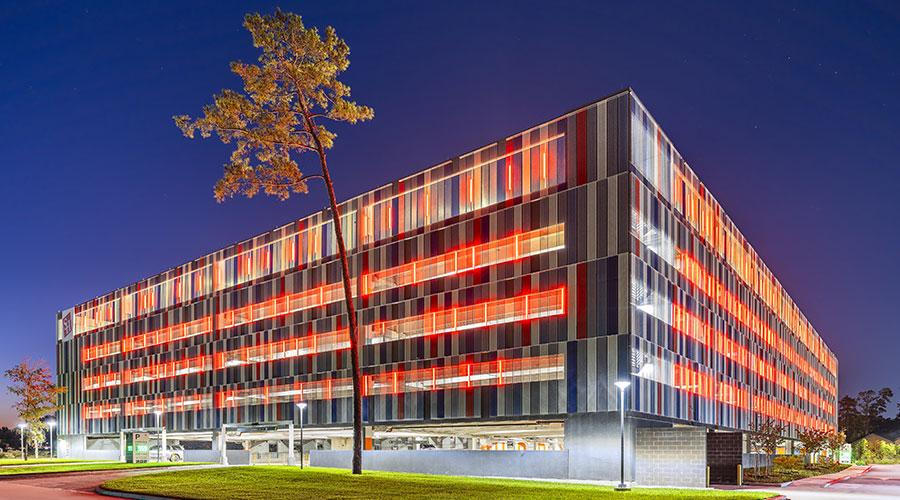Daylighting Benefits Lie in Proper Design, Control
Facility managers interested in finding ways to reduce their energy costs are revisiting daylighting options. Tapping the sun's rays can yield tremendous savings and may even improve employee morale, retail sales and overall productivity. And lessons learned from past problems with daylighting schemes can be used to prevent glare and excess heat and to ensure that expected energy savings are achieved.
For highest performance, modern daylighting often employs skylights and windows, along with photosensors, dimming electronic ballasts, light shelves, occupancy sensors and automated shades. But energy savings can also be achieved by using simple but effective options.
"When you have an amply day lit space, simply turn off the lights," says Lisa Heschong, managing principal of Heschong Mahone Group. "Or turn off half the lights."
At whatever level, numerous field studies completed in the past decade document the value of daylighting in reducing lighting and cooling energy costs. A correlation between daylight in classrooms and improvement in student performance also is often cited on the plus side of daylighting projects. Studies for Pacific Gas and Electric looked at daylighting and human productivity and found positive results in elementary student test scores and retail sales.
Later field studies for the California Energy Commission expanded on the visual benefits of windows for worker performance. In one of them, call center workers processed calls 6 to 12 percent faster when they had a view. And office workers performed 10 to 25 percent better on tests of mental function and memory recall. Views also are important considerations in buildings using daylighting as part of a LEED certification.
Too Much of a Good Thing
However, not all sunshine and views came up rosy in the study. Glare from windows decreased office worker performance by 15 to 21 percent.
Maureen Moran, principal with mcla Architectural Lighting Design, remembers a bank building with two stories of glass that allowed sunlight to cascade into the building. When she spoke to an employee, he told her that "after awhile, all that sunlight is just too much."
The problem is that direct sunlight is simply too bright. The natural tendency is to close the blinds and turn on the lights. "You're not benefitting from daylighting unless the lights are turned off or at least dimmed," says Scott Hackel, senior energy engineer for Energy Center of Wisconsin.
Rerouting direct sunlight to the ceiling and allowing it to be diffused over a larger area is one way to handle the problem of glare and bring daylighting advantages deeper into the building, according to Moran. Light shelves bounce the direct sunlight to the ceiling, diffusing it over a broader interior space.
"The problem is many buildings have an abundance of daylight at the perimeter," explains Moran. "To satisfy LEED requirements, however, you need to get more daylight into the building's core."
Light shelves and low partitions that are correctly positioned perpendicular to the daylight help to bring more light in. "Better distribution of the daylight also deals with glare or excess heat issues," Moran says.
Outside the building, overhangs can shield areas where daylight may offer too much of a good thing. Another relatively inexpensive solution is to use retractable awnings to control direct sunlight. This option is popular in Europe but has seen only limited use in the United States. A fixed shade or overhang outside can also block sun. But in general, movable systems are better solutions to daylight issues. As Heschong points out, "daylighting problems are dynamic and dynamic problems need dynamic solutions."
When Savings Fall Short
In addition to glare, some daylighting applications have fallen short of initial energy-saving projections. The good news is that low performance also is being studied, according to Heschong.
Two different field studies on daylighting performance showed a marked difference between skylighting, or top lighting, and windows, sometimes referred to as side lighting. The skylight applications came in at 98 percent of their design predictions. The spaces averaged an 80 percent savings in their lighting energy use and up to 15 percent savings for cooling in the daylit area.
Daylighting strategies using windows, however, showed a much higher failure rate. According to Heschong, 50 percent of the window applications were not working at all. And, of those working, half were not delivering optimal savings. The field study found many reasons for the poor performance of side lighting, but Heschong says most systems were not working because of high office partitions (5 or 6 feet tall) or because their closed-loop sensor was placed too deep inside the building.
But when daylighting is done right and the design elements are maintained, daylighting is a real success story. Heschong has monitored "daylighting applications that are 10 to 30 years old and still delivering savings."
Daylighting Payback
When calculating energy cost savings, Lindsay Audin, president of Energywiz, Inc., suggests that facility managers be aware of real electricity consumption pricing. Many utilities charge much higher rates during peak demand periods than during other times. For example, a daylighting system might save 16 or 17 cents per kilowatt hour from late afternoon to early evening, but only 9 to 12 cents per kilowatt hour during other daytime periods, when the majority of daylight savings occurs.
If the payback period is calculated on the peak demand kWh rate of 16 cents, for example, the system may be performing well, but the payback period may be much longer than expected, as the majority of energy savings occur during the 9 to 12 cents per kWh period.
— Rita Tatum
|
Related Topics:












